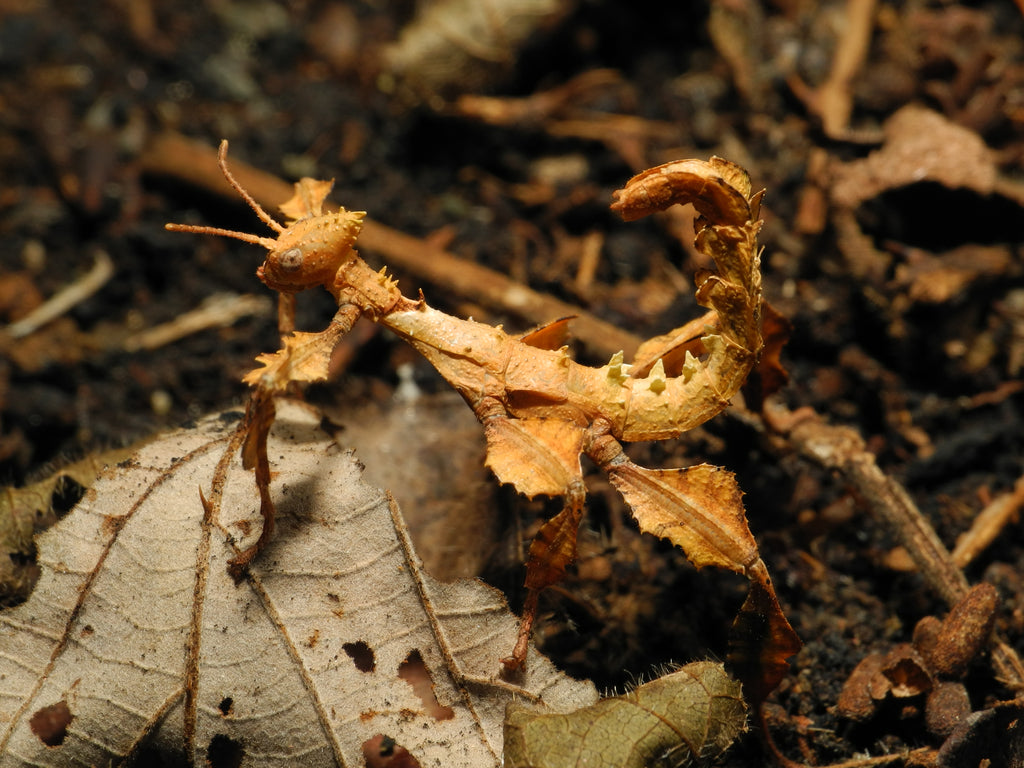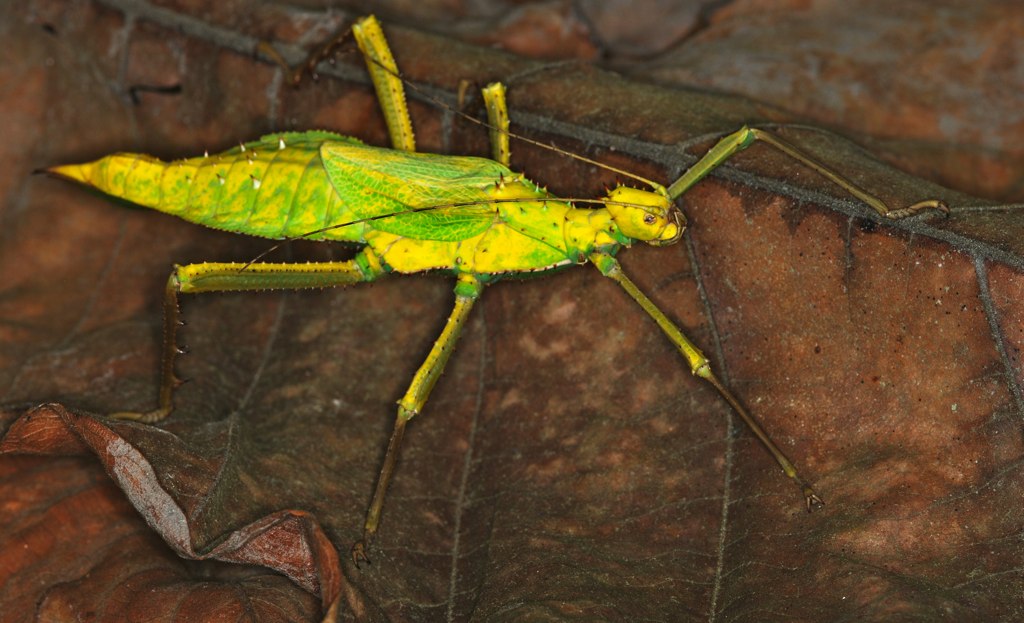The Indian stick insect (Carausius morosus) is a medium-sized, nocturnal, herbivorous invertebrate originally native to India. However, it is prolifically invasive across the globe, and has been reported in other locations such as the United States, Mexico, Portugal, France, England, South Africa, Madagascar, and Taiwan.
Indian stick insects grow 3-4” long, with males being smaller than females. Like all stick insects, they are designed for camouflage. This species lives up well to the “stick insect” nickname, with a body and limbs that resemble a twig. The body is uniform brown with twig-like texture, with long slender limbs and antennae. The base of each foreleg is bright red. Neither sex has functional wings.
The Indian stick insect is one of the most common stick insects in the pet trade, and also goes by the name “laboratory stick insect”. They are very easy to care for, with a lifespan of around one year.
Indian stick insects are known to be parthenogenic, which means that females can reproduce successfully without the aid of a male. This means that your pet will lay viable eggs. If you do not wish to raise the young, you will need to destroy the egg case before disposing of it. Otherwise, there is a possibility that the young will hatch and start an invasive population in your area!
How much space do Indian stick insects need?
The general rule with housing stick insects is that the enclosure length and width should be at least twice that of the stick insect’s expected adult length, and the height should be at least three times expected adult length. A good starting point is 8”W x 12”H. The enclosure should have a mesh top for your pet to hang from for molting, and it should be well ventilated. Full-mesh enclosures work very well in climates that are not particularly dry.
Indian stick insects can be housed in groups just fine. The important thing to remember for housing groups is that they will need more space, particularly horizontally.
Do Indian stick insects need special lighting?
As long as the stick insect’s enclosure is in a room that receives ~12 hours/day of artificial or bright natural light, then additional lighting equipment is unlikely to be necessary. However, if it is being kept in a dark room then ~6500K fluorescent or LED illumination is helpful.
Do not place your stick insect’s enclosure in front of a window, as the sunlight can overheat the enclosure and kill your pet!
What temperatures do Indian stick insects need?
Indian stick insects usually do well anywhere between 63°F and 77°F, so they can be kept at room temperature. Keep track of the temperatures inside your enclosure with a digital thermometer like the Zoo Med Digital Thermometer & Humidity Gauge, with the probe placed in the middle.
This wide range of tolerance generally means that Indian stick insects can be kept comfortably at room temperature without supplementary heating. Just make sure they’re kept in a room that doesn’t get too warm during summer.
What humidity levels do Indian stick insects need?
Humidity is very important for successfully keeping stick insects as pets, as it helps ensure successful molting and general wellbeing. That being said, Indian stick insects aren’t terribly picky about their ambient humidity.
It’s good practice to lightly mist your pet’s enclosure with a spray bottle every evening to increase humidity and provide water for your pet to drink. Tap water is okay to use, but only if you dechlorinate it first. If this is not possible, it’s best to use distilled water.
What substrate is good for Indian stick insects?
Substrate is important to a stick insect setup because it helps maintain healthy humidity levels. It’s best not to go bioactive, as your stick insect will eat the plants. Here are some better substrate options:
- Zoo Med Creatures Eco Soil
- Zoo Med Creature Soil
- Zoo Med ReptiBark
- Eco Earth Plantation Soil
- Exo Terra Forest Bark
- Zilla Bark Blend
You don’t need very much substrate. Depending on the size of the enclosure, 1-2” should be plenty.
To keep your stick insect’s enclosure clean, replace the substrate weekly and completely rinse out the enclosure and décor with hot water. Don’t use soap or disinfectants, as the residue may harm your pet!
What décor can you use in an Indian stick insect terrarium?
Indian stick insects like having things to climb and hide amongst in their enclosure. This encourages natural behaviors, which makes them more fun to watch, and decreases stress, which in turn increases lifespan. Here are some ideas:
Climbing objects should be arranged at a variety of angles to give your pet options. Hot glue is excellent for adhering climbing objects and artificial foliage to terrarium walls.
Make sure to leave an open space at the top of the enclosure twice the height of your pet for molting.
What do Indian stick insects eat?
Indian stick insects are herbivorous, which means that they eat plants. They eat leaves from the following plants:
- Blackberry (older leaves only, no new leaves)
- Oak
- Hawthorn
- Azalea
- Camellia
- Geranium
- Hibiscus
- Ivy
- Jasmine
- Privet
- Pyracantha
- Rose
- Hazel
Food should be available every other day — it’s not a good idea to starve your stick insect! It’s best to offer a branch of leaves, placed in a weighted vase of water to keep the leaves fresh for as long as possible.
Oak leaves freeze well for winter, and blackberry leaves usually stay available throughout winter. If you are having difficulty sourcing appropriate leaves for your stick insect to eat, romaine lettuce can be used in a pinch.
Never use leaves from garden centers or florists, as these are likely to be treated with insecticides that will kill your pet! It is also best to avoid collecting leaves near roads, as they are contaminated with vehicle exhaust.
Do Indian stick insects like to be handled?
Generally speaking, pet invertebrates don’t like to be handled very much, but Indian stick insects tolerate it better than most. To handle your pet stick insect, place your hand under its front legs and use your other hand to scoop it up from behind. Be very gentle and let the stick insect come off the branch onto your hand of its own volition — otherwise can get injured!
*This care sheet contains only very basic information. Although it’s a good introduction, please do further research with high-quality sources to obtain additional information on caring for this species.
"Carausius morosus (Indian stick insect)" by Resenter1 is licensed under CC BY 2.0




Leave a comment
This site is protected by hCaptcha and the hCaptcha Privacy Policy and Terms of Service apply.